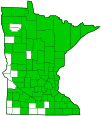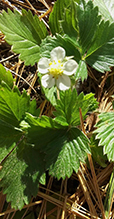woodland strawberry
(Fragaria vesca ssp. americana)
Conservation • Wetland • Description • Habitat • Ecology • Use • Distribution • Taxonomy
Description |
Woodland strawberry 4″ to 6″ tall, erect, perennial forb is found in the woods, hence the common name. The leaves are three-parted and are borne on long, hairy stalks that emerge from the central taproot in the ground. The leaflets are bright green to yellowish-green, coarsely toothed, and thin. They are stalkless. The terminal tooth of the leaflet is more than half as wide and as long or longer than (protrudes beyond or equals) the two adjacent teeth. A line drawn between the tips of the two adjacent teeth passes through the terminal tooth. The lateral veins branch off of the central vein at an angle of about 45°. The flowers sit well above the leaves. They are borne on separate, long stalks from the central taproot in the ground. The flower has 5 petals and is ½″ wide. The fruit is an accessory fruit, not a berry. It consists of a fleshy receptacle with achenes on the surface. It is slender and elliptical. The seed-like achenes sit on the surface of the receptacle. |
Height |
4″ to 6″ |
Flower Color |
White |
Similar Species |
Wild strawberry (Fragaria virginiana) has larger flowers and fruit. The flowers sit at about the same height as the leaves. The leaves are narrower and more tapering. The terminal tooth is narrower (less than half as wide) and shorter (does not protrude beyond) than the two adjacent teeth. A line drawn between the tips of the two adjacent teeth passes above the terminal tooth. The seed-like achenes are positioned in shallow pits on the surface of the receptacle. |
Habitat |
Woodlands |
Ecology |
Flowering |
April to June |
Pests and Diseases |
|
Use |
|
Distribution |
||
|
Sources |
|
| 4/22/2024 | ||
Nativity |
||
Native |
||
Occurrence |
||
Common |
||
Taxonomy |
|
Kingdom |
Plantae (green algae and land plants) |
Subkingdom |
Viridiplantae (green plants) |
Infrakingdom |
Streptophyta (land plants and green algae) |
Superdivision |
|
Division |
Tracheophyta (vascular plants) |
Subdivision |
Spermatophytina (seed plants) |
Class |
|
Superorder |
Rosanae |
Order |
Rosales (roses, elms, figs, and allies) |
Family |
Rosaceae (rose) |
Subfamily |
Rosoideae (brambles, roses, strawberries, and allies) |
Tribe |
Potentilleae (strawberries, cinquefoils, and allies) |
Subtribe |
Fragariinae (strawberry) |
Genus |
Fragaria (strawberries) |
Subordinate Taxa |
|
|
|
Synonyms |
|
Fragaria americana Fragaria vesca var. americana |
|
Common Names |
|
hillside strawberry thin-leaved wild strawberry wood strawberry woodland strawberry |
|
Glossary
Accessory fruit
A fruit formed from the ovary but containing much fleshy tissue derived from adjacent parts, such as an apple. pear, or strawberry.
Achene
A dry, one-chambered, single-seeded fruit, formed from a single carpel, with the seed attached to the membranous outer layer (wall) only by the seed stalk; the wall, formed entirely from the wall of the superior ovary, does not split open at maturity, but relies on decay or predation to release the contents.
Receptacle
The thickened, upper part of a flower stalk to which flowers or flower parts are attached. In composite flowers, the part on which the flowers are borne. In accessory fruits the receptacle gives rise to the edible part of the fruit.
Visitor Photos |
||
Share your photo of this plant. |
||
This button not working for you? |
||
Luciearl |
||
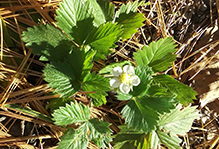 |
||
MinnesotaSeasons.com Photos |
||
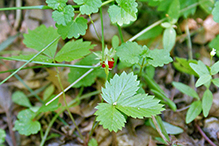 |
||
Leaves |
||
 |
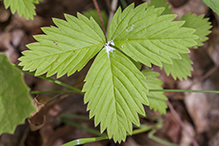 |
|
Leaf |
||
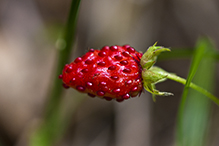 |
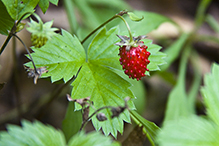 |
|
Fruit |
||

Slideshows |
Fragaria vesca |
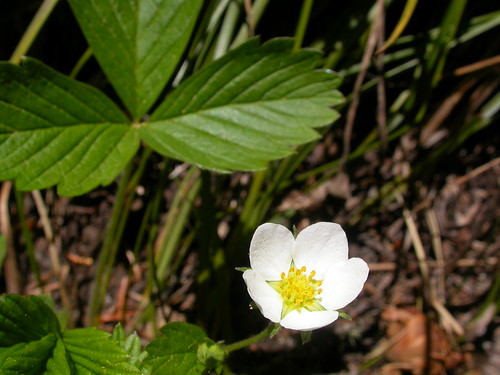
|
About
Fruit: multiple achenes on a fleshy receptacle (accessory). Compared to Fragaria virginiana, Fragaria vesca has greener and more prominently veined leaves and is more understory inhabiting. Stoloniferous scapose perennial herb with a creeping growth habit, common in meadows, grasslands, and forests at all elevations in the mountainous regions of Montana. |
Fragaria vesca (with translation text) |
About
Uploaded on Oct 28, 2010 More information??? Review: Contact: officinalis.com@gmail.com |

Visitor Videos |
||
Share your video of this plant. |
||
This button not working for you? |
||
|
Other Videos |
||
Fragaria vesca L. - Fragolina di bosco |
About
Uploaded on Feb 25, 2008 Delizioso frutto di bosco dal profumo intenso e dal sapore gradevolissimo, nei mesi di Maggio e Giugno macchia di rosso il sottobosco dell'area mediterranea. Video tratto dalla VideoTeca del Micologo Pietro Curti: Presidente dell'Associazione AMINT: |
The wealth around us - Wild edibles: Woodland strawberry s2e38 |
About
Uploaded on Apr 15, 2011 Fragaria vesca, commonly known as the Woodland Strawberry, occurs naturally throughout the Northern Hemisphere. Other names for this species include Fraises des Bois, Wild (European) Strawberry, European Strawberry and Alpine Strawberry (the latter is the most common type in cultivation, which usually is nearly always everbearing, and produces few runners). Typical habitat is along trails and roadsides, embankments, hillsides, stone- and gravel-laid paths and roads, meadows, young woodlands, sparse forest, woodland edges, and clearings. Often plants can be found where they do not get sufficient light to form fruit. In the southern part of its range, it can only grow in shady areas; further north it tolerates more sun.[1] It is tolerant of a variety of moisture levels (except very wet or dry conditions).[1] It can survive mild fires and/or establish itself after fires.[1] Although F. vesca primarily propagates via runners, viable seeds are also found in soil seed banks and seem to germinate when the soil is disturbed (away from existing populations of F. vesca).[1] Its leaves serve as significant food source for a variety of ungulates, such as mule deer and elk, and the fruit are eaten by a variety of mammals and birds that also help to distribute the seeds in their droppings. Woodland strawberry fruit is strongly flavored, and is still collected and grown for domestic use and on a small scale commercially for the use of gourmets and as an ingredient for commercial jam, sauces, liqueurs, cosmetics and alternative medicine. In Turkey hundreds of tons of wild fruit are harvested annually, mainly for export.[3] Most of the cultivated varieties have a long flowering period (and have been considered by botanists as belonging to Fragaria vesca var. vesca ssp. semperflorens). They are usually called alpine strawberries. They either form runners or multiple crowns in a cluster, fruit over a very long period with larger fruit than the common wood strawberry, and are usually propagated by seeds or division of the plants. Their fruit are usually much larger than that of the wild form. Large-fruiting forms are known since the 18th century and were called "Fressant" in France.[4] Some cultivars have fruit that are white or yellow when fully ripe, instead of the normal red. |
Cultivo de la fresa: Fragaria vesca (http://elagricultoreficiente.blogspot.com.es/) |
About
Published on Feb 6, 2013 Suscríbete al Canal: https://www.youtube.com/user/agricultoreficiente Plantas de fresa en caballones recubiertos de lámina de plástico (http://elagricultoreficiente.blogspot.com.es/) |
Bosaardbei Fragaria vesca 10 mei 2011.wmv |
About
Uploaded on May 14, 2011 Sprekend een gewone aardbei maar alles is wat kleiner en niet het minst belangrijk, ook de vruchten die echter toch heerlijk zoet en vol van smaak zijn. |

Visitor Sightings |
||
Report a sighting of this plant. |
||
This button not working for you? |
||
Luciearl |
Location: Lake Shore (growing in sand of parking area) |
 |
MinnesotaSeasons.com Sightings |
||

|
Created: Last Updated: © MinnesotaSeasons.com. All rights reserved. |
